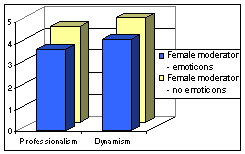Media Effects Research Lab - Research Archive
Impression formation effects in moderated chatrooms: An experimental study of gender differences
Student Researcher(s)
Corina Constantin (Ph.D Candidate);
Sriram Kalyanaraman (Ph.D Candidate);
Carmen Stavrositu (Ph.D Candidate);
Nathan Wagoner (Ph.D Candidate);
Faculty Supervisor
FOR A COMPLETE REPORT OF THIS RESEARCH, SEE:
Constantin, C., Kalyanaraman, S., Stavrositu, C., & Wagoner, N. (2002, November). Impression formation effects in moderated chatrooms: An experimental study of gender differences. Poster presented at the 88th annual meeting of the National Communication Association (NCA), New Orleans, LA.
INTRODUCTION
It is generally accepted that nonverbal cues (such as body language) are important indicators of impression formation in Face-to-Face (FtF) interactions. In online interactions, or Computer-Mediated Communication (CMC), these cues take the form of graphic signs, such as emoticons, that can carry into CMC the same socio-emotional information and perform similar roles as nonverbal cues in FtF. In this context, one question that has received considerable attention pertains to perceptions of the "other" in mediated environments. The present study attempts to answer this question by examining impression-formation effects of male and female moderators in online chatrooms.
HYPOTHESIS
Impressions formed by participants about a male moderator’s use/non-use of emoticons in a chatroom will differ from the impressions formed by participants about a female moderator’s use /non-use of emoticons.
METHOD
A total of 58 participants took part in a between-subjects experiment. All participants were randomly exposed to one of four experimental conditions, as follows: just moderator with emoticons, just chatters with emoticons, everybody with emoticons, and none with emoticons. Two chat transcripts containing the same four conditions but led by two different moderators were created: San Francisco Chat (female moderator) and Reality vs. Imagination Chat (male moderator). Participants were evenly spread across the four conditions of the two chat transcripts. After their exposure to the chat transcripts, participants’ impressions of the moderators were measured via their responses to questions included in a paper-and-pencil questionnaire.
RESULTS
H1: Supported.
The dependent measure of impression formation was divided into six factors called “Conscientiousness,” “Boldness,” “Intensity,” “Professionalism,” “Dynamism,” and “Confidence.”
Professionalism: Use of emoticons did not influence impressions formed about male moderators. However, impressions formed about female moderators were affected, such that they were rated as significantly more professional when they did not use emoticons than when they did.
Dynamism: Female moderators were perceived as significantly less dynamic when they used emoticons than when they did not. For male moderators, perceptions of dynamism were not differentially affected by their emoticon use.

CONCLUSION
The findings from this study indicate that while impressions formed about male moderators are not affected by emoticons’ use, the ones formed about female moderators are significantly influenced both by emoticons’ use and by the context in which emoticons are used. Previous research has shown that in CMC contexts, women are more likely than men to engage in socio-emotional and relational patterns of communication. Accordingly, one possible explanation for our findings could be that use of emoticons by female moderators makes them appear as excessively emotional, too casual, not authoritative or expert enough to be taken seriously and, consequently, their competence as moderators is being questioned.
For more details regarding the study contact
Dr. S. Shyam Sundar by e-mail at sss12@psu.edu or by telephone at (814) 865-2173

